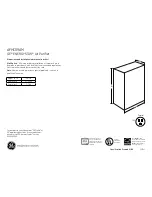
SLEEP
8-6. AUTO VANE OPERATION
(1) Vane motor drive
This model is equipped with a stepping motor for the horizontal vane. The rotating direction, speed, and angle of the
motor are controlled by pulse signals (approx. 12V) transmitted from indoor microprocessor.
(2) The horizontal vane angle and mode changes as follows by pressing the VANE CONTROL (
) button.
8-5. FAN MOTOR CONTROL
(1) Rotational frequency feedback control
The indoor fan motor is equipped with a rotational frequency sensor, and outputs signal to the microprocessor to feed
back the rotational frequency. Comparing the current rotational frequency with the target rotational frequency
(Hi,Me,Lo,SLEEP), the microprocessor controls IC141 and adjusts fan motor electric current to make the current
rotational frequency close to the target rotational frequency. With this control, when the fan speed is switched, the
rotational frequency changes smoothly.
(2) Fan motor lock-up protection
When the rotational frequency feedback signal has not output for 12 seconds, (or when the microprocessor cannot
detect the signal for 12 seconds) the fan motor is regarded locked-up. Then the electric current to the fan motor is shut
off. 3 minutes later, the electric current is applied to the fan motor again. During the fan motor lock-up, the Operation
Indicator lamp flashes on and off to show the fan motor abnormality. (See page 23.)
16
①
In COOL and DRY operation
➁
In HEAT operation
Vane angle is fixed to Angle 1.
Vane angle is fixed to Angle 4.
(3) Positioning
The vane is once pressed to the vane stopper below to confirm the standard position and then set to the desired angle.
Confirming of standard position is performed in case of follows.
(a) When the OPERATE/STOP (ON/OFF) button is pressed.
(b) When the vane control is changed from AUTO to MANUAL.
(c) When the SWING is finished.
(d) When the test run starts.
(e) When the power supply turns ON.
(4) VANE AUTO (
) mode
In VANE AUTO mode, the microprocessor automatically determines the vane angle and operation to make the optimum
room-temperature distribution.
















































